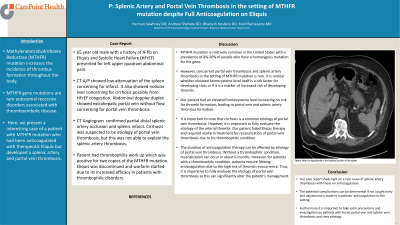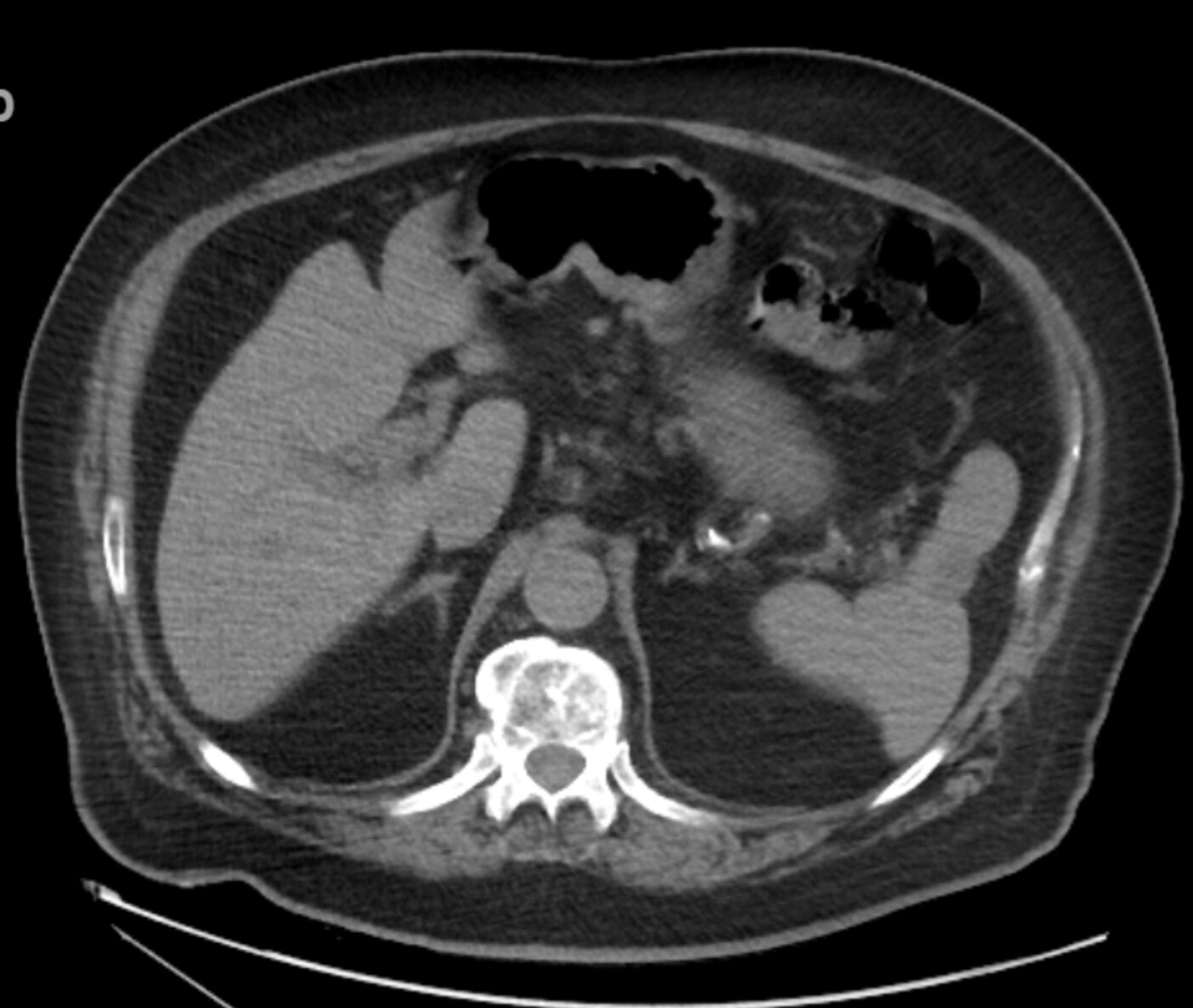Sunday Poster Session
Category: Stomach
P1668 - Splenic Artery and Portal Vein Thrombosis in the setting of MTHFR mutation despite Full Anticoagulation on Eliquis
Sunday, October 27, 2024
3:30 PM - 7:00 PM ET
Location: Exhibit Hall E

Has Audio

Harman Sawhney, DO
Bayonne Medical Center
Bayonne, NJ
Presenting Author(s)
Harman Sawhney, DO1, Dhanush Hoskere, DO1, Kovil Ramasamy, MD2, Andrew Shehata, DO3
1Bayonne Medical Center, Bayonne, NJ; 2CarePoint Health - Bayonne Medical Center, Bayonne, NJ; 3CarePoint Health, Bayonne, NJ
Introduction: Methylenetetrahydrofolate Reductase (MTHFR) mutation increases the incidence of thrombus formation throughout the body. MTHFR gene mutations are rare autosomal recessive disorders associated with thromboembolic disease. Here, we present a patient with MTHFR mutation who had been anticoagulated with therapeutic eliquis but developed a splenic artery and portal vein thrombosis.
Case Description/Methods: 65 year old male with a history of afib on Eliquis and systolic heart failure (HFrEF) presented for left upper quadrant abdominal pain. CTAP showed low attenuation of spleen concerning for infarct and nodular liver concerning for cirrhosis possibly from HFrEF congestion. Abdominal doppler showed extrahepatic portal vein without flow concerning for portal vein thrombosis. CTA confirmed partial distal splenic artery occlusion and splenic infarct. Cirrhosis was suspected to be etiology of portal vein thrombosis, but this was not able to explain the splenic artery thrombosis. Patient had thrombophilia work up which was positive for two copies of the MTHFR mutation. Eliquis was discontinued and warfarin started due to its increased efficacy in patients with thrombophilic disorders.
Discussion: MTHFR mutation is relatively common in the United States with a prevalence of 8%-20% of people who have a homozygous mutation for the gene. However, concurrent portal vein thrombosis and splenic artery thrombosis in the setting of MTHFR mutation is rare. It is unclear whether elevated homocysteine level itself is a risk factor for developing clots or if it is a marker of increased risk of developing thrombi. Our patient had an elevated homocysteine level increasing his risk for thrombi formation, leading to portal vein and splenic artery thrombus formation.
It is important to note that cirrhosis is a common etiology of portal vein thrombosis. However, it is important to fully evaluate the etiology of the arterial thrombi. Our patient failed eliquis therapy and required warfarin treatment for recanalization of portal vein thrombosis due to his thrombophilic condition. The duration of anticoagulation therapy can be affected by etiology of portal vein thrombosis. Without a thrombophilic condition, recanalization can occur in about 6 months. However, for patients with a thrombophilic condition, patients require lifelong anticoagulation due to the high risk of thrombi reoccurrence. Thus, it is imperative to fully evaluate the etiology of portal vein thrombosis as this can significantly alter the patient’s management.

Disclosures:
Harman Sawhney, DO1, Dhanush Hoskere, DO1, Kovil Ramasamy, MD2, Andrew Shehata, DO3. P1668 - Splenic Artery and Portal Vein Thrombosis in the setting of MTHFR mutation despite Full Anticoagulation on Eliquis, ACG 2024 Annual Scientific Meeting Abstracts. Philadelphia, PA: American College of Gastroenterology.
1Bayonne Medical Center, Bayonne, NJ; 2CarePoint Health - Bayonne Medical Center, Bayonne, NJ; 3CarePoint Health, Bayonne, NJ
Introduction: Methylenetetrahydrofolate Reductase (MTHFR) mutation increases the incidence of thrombus formation throughout the body. MTHFR gene mutations are rare autosomal recessive disorders associated with thromboembolic disease. Here, we present a patient with MTHFR mutation who had been anticoagulated with therapeutic eliquis but developed a splenic artery and portal vein thrombosis.
Case Description/Methods: 65 year old male with a history of afib on Eliquis and systolic heart failure (HFrEF) presented for left upper quadrant abdominal pain. CTAP showed low attenuation of spleen concerning for infarct and nodular liver concerning for cirrhosis possibly from HFrEF congestion. Abdominal doppler showed extrahepatic portal vein without flow concerning for portal vein thrombosis. CTA confirmed partial distal splenic artery occlusion and splenic infarct. Cirrhosis was suspected to be etiology of portal vein thrombosis, but this was not able to explain the splenic artery thrombosis. Patient had thrombophilia work up which was positive for two copies of the MTHFR mutation. Eliquis was discontinued and warfarin started due to its increased efficacy in patients with thrombophilic disorders.
Discussion: MTHFR mutation is relatively common in the United States with a prevalence of 8%-20% of people who have a homozygous mutation for the gene. However, concurrent portal vein thrombosis and splenic artery thrombosis in the setting of MTHFR mutation is rare. It is unclear whether elevated homocysteine level itself is a risk factor for developing clots or if it is a marker of increased risk of developing thrombi. Our patient had an elevated homocysteine level increasing his risk for thrombi formation, leading to portal vein and splenic artery thrombus formation.
It is important to note that cirrhosis is a common etiology of portal vein thrombosis. However, it is important to fully evaluate the etiology of the arterial thrombi. Our patient failed eliquis therapy and required warfarin treatment for recanalization of portal vein thrombosis due to his thrombophilic condition. The duration of anticoagulation therapy can be affected by etiology of portal vein thrombosis. Without a thrombophilic condition, recanalization can occur in about 6 months. However, for patients with a thrombophilic condition, patients require lifelong anticoagulation due to the high risk of thrombi reoccurrence. Thus, it is imperative to fully evaluate the etiology of portal vein thrombosis as this can significantly alter the patient’s management.

Figure: Splenic Infarct as hypodensity in the body/tail junction of the spleen
Disclosures:
Harman Sawhney indicated no relevant financial relationships.
Dhanush Hoskere indicated no relevant financial relationships.
Kovil Ramasamy indicated no relevant financial relationships.
Andrew Shehata indicated no relevant financial relationships.
Harman Sawhney, DO1, Dhanush Hoskere, DO1, Kovil Ramasamy, MD2, Andrew Shehata, DO3. P1668 - Splenic Artery and Portal Vein Thrombosis in the setting of MTHFR mutation despite Full Anticoagulation on Eliquis, ACG 2024 Annual Scientific Meeting Abstracts. Philadelphia, PA: American College of Gastroenterology.
